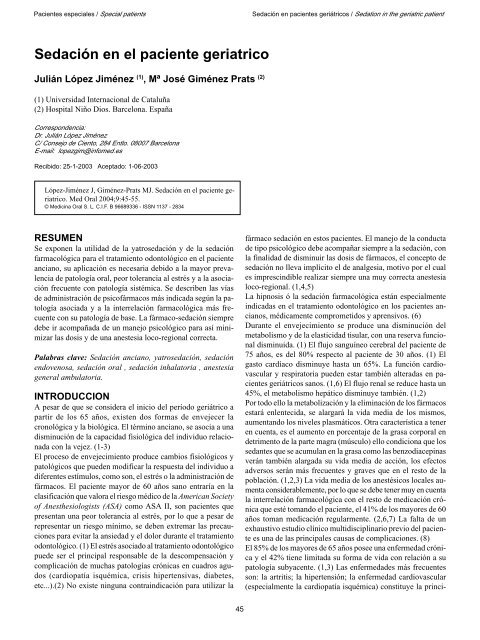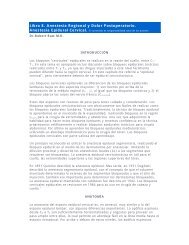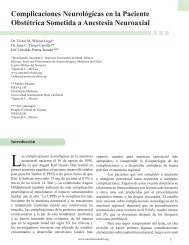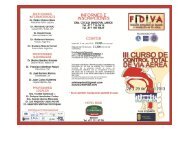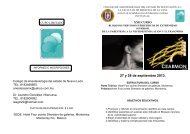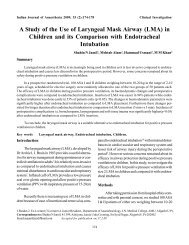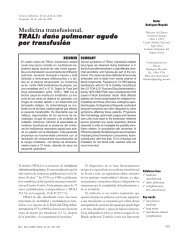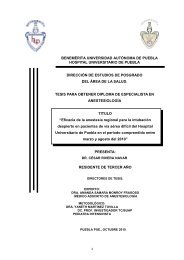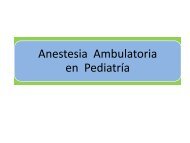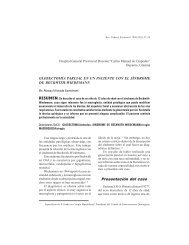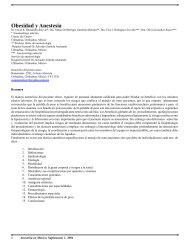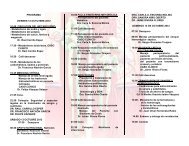Sedación en el paciente geriatrico - Medicina Oral Patologia Oral y ...
Sedación en el paciente geriatrico - Medicina Oral Patologia Oral y ...
Sedación en el paciente geriatrico - Medicina Oral Patologia Oral y ...
- No tags were found...
Create successful ePaper yourself
Turn your PDF publications into a flip-book with our unique Google optimized e-Paper software.
Paci<strong>en</strong>tes especiales / Special pati<strong>en</strong>ts Sedación <strong>en</strong> paci<strong>en</strong>tes geriátricos / Sedation in the geriatric pati<strong>en</strong>tLos c<strong>en</strong>tros respiratorios superiores se activan normalm<strong>en</strong>te al<strong>el</strong>evarse la presión parcial de CO2, <strong>en</strong> estos paci<strong>en</strong>tes <strong>en</strong> queestas conc<strong>en</strong>traciones están siempre <strong>el</strong>evadas se produce <strong>el</strong> estímulorespiratorio al disminuir la presión parcial de oxíg<strong>en</strong>o. Elloimplica que si se manti<strong>en</strong>e al paci<strong>en</strong>te con unos niv<strong>el</strong>es altos deoximetría se podría producir una apnea.Los fármacos sedantes pose<strong>en</strong> todos <strong>el</strong>los la capacidad de produciruna insufici<strong>en</strong>cia respiratoria, por <strong>el</strong>lo se deb<strong>en</strong> administrar<strong>en</strong> estos casos con una especial precaución, recom<strong>en</strong>dándose lautilización de b<strong>en</strong>zodiacepinas o propofol, por su m<strong>en</strong>or efectodepresor respiratorio. Los barbitúricos y los opiáceos estaríancontraindicados al t<strong>en</strong>er mayor probabilidad de producirbrocoespasmo además de su mayor poder depresor respiratorio,tampoco está indicada la utilización de antihistamínicos yanticolinérgicos (atropina, escopolamina), ya que aum<strong>en</strong>tan lasequedad mucosa y la viscosidad de la secreción respiratoria. (2)Es importante valorar la posición d<strong>el</strong> paci<strong>en</strong>te durante <strong>el</strong> tratami<strong>en</strong>to,por que ti<strong>en</strong><strong>en</strong> una t<strong>en</strong>d<strong>en</strong>cia a la ortopnea , se debemant<strong>en</strong>er <strong>en</strong> la posición que respire más cómodam<strong>en</strong>te (Normalm<strong>en</strong>te<strong>en</strong> Tr<strong>en</strong>d<strong>el</strong>emburg , con <strong>el</strong> respaldo de 30 - 45º aproximadam<strong>en</strong>te)(13).Se recomi<strong>en</strong>da la vía oral como premedicación ansiolítica. Lavía inhalatoria también se puede utilizar, ya que la apnea producidapor un aum<strong>en</strong>to de la presión parcial de oxíg<strong>en</strong>o es improbableque aparezca (1); es importante para su prev<strong>en</strong>ción lamonitorización de la oximetría previam<strong>en</strong>te a la interv<strong>en</strong>ción ymant<strong>en</strong>erla <strong>en</strong> niv<strong>el</strong>es similares durante todo <strong>el</strong> procedimi<strong>en</strong>to.(1) En casos de <strong>en</strong>fermos con <strong>en</strong>fisema, la administración deóxido nitroso se debe llevar con gran precaución, ya que <strong>el</strong> gasse puede acumular <strong>en</strong> los espacios aéreos pulmonares <strong>en</strong>sanchadosy persistir los efectos sedantes durante más tiempo, <strong>en</strong>estos casos la v<strong>en</strong>taja d<strong>el</strong> ajuste escalonado de la dosis estaríatambién comprometida. La sedación por vía <strong>en</strong>dov<strong>en</strong>osa, si s<strong>el</strong>leva a cabo, debería ser <strong>en</strong> medio hospitalario, con un aporteadicional de oxíg<strong>en</strong>o ( mascarilla nasal a 2-3 l./mín.) y con unaestricta monitorización. (13,14)Como interacciones farmacológicas destacan losbroncodilatadores beta-adr<strong>en</strong>érgicos con las aminas presorasde los anestésicos locales, también se debe valorar <strong>el</strong> aum<strong>en</strong>tode la dosis de corticoides <strong>en</strong> paci<strong>en</strong>tes que ya lo toman de caraa controlar <strong>el</strong> estrés psíquico y físico. (2)-ENFERMEDAD RENAL: La insufici<strong>en</strong>cia r<strong>en</strong>al crónica es lacausa más frecu<strong>en</strong>te responsable de la modificación de los protocoloshabituales de tratami<strong>en</strong>to odontológico. Para su tratami<strong>en</strong>tomédico se utiliza la diálisis o <strong>el</strong> trasplante. (2) Al estardisminuida la excreción de los fármacos de <strong>el</strong>iminación r<strong>en</strong>al,permanecerán niv<strong>el</strong>es hemáticos más <strong>el</strong>evados durante mástiempo, con <strong>el</strong> riesgo consecu<strong>en</strong>te de sobredosis. Se recomi<strong>en</strong>darealizar <strong>el</strong> tratami<strong>en</strong>to <strong>el</strong> día sigui<strong>en</strong>te a la diálisis, <strong>en</strong> esemom<strong>en</strong>to es cuando se halla más normalizado su estadometabólico. Los sedantes tipo b<strong>en</strong>zodiacepinas o los opiáceosse pued<strong>en</strong> administrar sin problemas de forma habitual, losanestésicos locales tipo amida también se pued<strong>en</strong> administrarde forma habitual y su asociación con vasoconstrictores no estácontraindicada. (2,7)No hay ninguna vía de administración contraindicada, si bi<strong>en</strong>,se recomi<strong>en</strong>da la vía oral <strong>en</strong> niv<strong>el</strong>es superficiales ó comopremedicación ansiolítica, La vía inhalatoria o la <strong>en</strong>dov<strong>en</strong>osaserían las de <strong>el</strong>ección para una sedación más profunda. (1)-ALTERACIONES NEUROLOGICAS Y PSIQUIATRICAS:Las personas mayores pres<strong>en</strong>tan una <strong>el</strong>evada preval<strong>en</strong>cia decomplicaciones psiquiátricas asociadas con patologías médicas.La depresión afecta d<strong>el</strong> 15 al 20% de los ancianos. (2,15)Estos paci<strong>en</strong>tes pres<strong>en</strong>tan una mayor preval<strong>en</strong>cia de patologíaoral, debido a que la ansiedad que les produce acudir a la consultaconstituye una barrera para su asist<strong>en</strong>cia, la dificultad quepres<strong>en</strong>tan para poder mant<strong>en</strong>er una correcta higi<strong>en</strong>e oral y <strong>el</strong>hábito de polifarmacia pued<strong>en</strong> ocasionar un síndrome de bocaseca. (16,17)La dem<strong>en</strong>cia por su frecu<strong>en</strong>cia y características de comportami<strong>en</strong>toconstituye una <strong>en</strong>tidad a t<strong>en</strong>er <strong>en</strong> cu<strong>en</strong>ta. Es un trastornog<strong>en</strong>eralizado d<strong>el</strong> int<strong>el</strong>ecto, la memoria y la personalidad sinafectar a la consci<strong>en</strong>cia. (3,15) Se distingue d<strong>el</strong> retraso m<strong>en</strong>tal<strong>en</strong> que es adquirida y normalm<strong>en</strong>te progresiva. La <strong>en</strong>fermedadde Alzheimer, constituye <strong>el</strong> 70% de los casos de dem<strong>en</strong>cia, supreval<strong>en</strong>cia aum<strong>en</strong>ta con la edad desde <strong>el</strong> 3% <strong>en</strong> los individuosde 65 a 74 años hasta <strong>el</strong> 40% de los mayores de 85 años. (2,17)Se produce una pérdida de neuronas y de la función neurológicacinco veces superior al proceso normal de <strong>en</strong>vejecimi<strong>en</strong>to. (3,15-17) Dep<strong>en</strong>di<strong>en</strong>do d<strong>el</strong> grado de evolución pued<strong>en</strong> producirseestados de disforia con comportami<strong>en</strong>tos impredecibles, <strong>el</strong>loserá determinante para la <strong>el</strong>ección de la vía de sedación y laprofundidad de la misma. La técnica <strong>en</strong>dov<strong>en</strong>osa puede ser la<strong>el</strong>ección por permitir <strong>el</strong> ajuste escalonado y requerir m<strong>en</strong>oscolaboración que la vía inhalatoria. (1) No existe ninguna contraindicaciónpara la utilización de anestésicos locales de tipoamida ni de vasoconstrictores salvo que coexista una <strong>en</strong>fermedadsistémica. (15)La <strong>en</strong>fermedad de Parkinson, es una <strong>en</strong>fermedad deg<strong>en</strong>erativad<strong>el</strong> sistema nervioso c<strong>en</strong>tral debida a la pérdida de fibrasdopadr<strong>en</strong>érgicas de los ganglios basales d<strong>el</strong> cerebro. (1) El 11%de las personas mayores de 65 años sufr<strong>en</strong> <strong>en</strong>fermedad deParkinson. (2,3) Los primeros síntomas pued<strong>en</strong> ser unabradipsíquia y un cambio <strong>en</strong> la conducta, también se puedeacompañar <strong>en</strong> las primeras fase de depresión; la progresión su<strong>el</strong>eser l<strong>en</strong>ta. (2,15) La expresión facial rígida, los movimi<strong>en</strong>toscorporales l<strong>en</strong>tos con t<strong>en</strong>d<strong>en</strong>cia a la rigidez y <strong>el</strong> temblor de lasmanos son características de la <strong>en</strong>fermedad ya instaurada. (15)Las facultades m<strong>en</strong>tales no están alteradas, por lo cual es muyimportante <strong>el</strong> manejo psicológico <strong>en</strong> estos casos. Al ir progresandola <strong>en</strong>fermedad se asocia a depresión, <strong>en</strong> fases más avanzadasse desarrollan signos de dem<strong>en</strong>cia. (1,2,15) El diagnósticosde certeza sólo puede establecerse a través de la autopsiaevid<strong>en</strong>ciando la atrofia cortical y <strong>el</strong> aum<strong>en</strong>to de tamaño de losv<strong>en</strong>trículos, por lo que se llega al diagnóstico por los signos ysíntomas característicos. (2,15-17)Las interacciones farmacológicas más frecu<strong>en</strong>tes de lospsicofármacos más utilizados son las sigui<strong>en</strong>tes:A)Antidepresivos tricíclicos: pot<strong>en</strong>cian <strong>el</strong> efecto depresor d<strong>el</strong>SNC, de todos los sedantes; pot<strong>en</strong>cian <strong>el</strong> efecto de otrosanticolinérgicos como los antihistamínicos o la atropina; pot<strong>en</strong>cian<strong>el</strong> efecto simpáticomimético de otras aminas presoras47
Med <strong>Oral</strong> 2004;9:45-55.Sedación <strong>en</strong> paci<strong>en</strong>tes geriátricos / Sedation in the geriatric pati<strong>en</strong>tcomo la adr<strong>en</strong>alina y la noradr<strong>en</strong>alina . La sobredosificaciónde un antidepresivo tricíclico se manifiesta con la aparición deun efecto anticolinérgicos , alteraciones de la frecu<strong>en</strong>cia cardíaca(taquicardia) y arritmias. (2,7,15)B) Litio, se utiliza para prev<strong>en</strong>ir estados maníacos agudos <strong>en</strong>los trastornos bipolares, las complicaciones derivadas de la tomacrónica de litio se c<strong>en</strong>tran <strong>en</strong> depresión tiroidea y arritmias conalteraciones de la onda T, por lo que cualquier tratami<strong>en</strong>to desedación se debe acompañar de una monitorización constanted<strong>el</strong> registro <strong>el</strong>ectrocardiográfico. (7,13,15)C) Ansiolíticos, los más utilizados son las b<strong>en</strong>zodiacepinas,todos los fármacos depresores d<strong>el</strong> SNC ti<strong>en</strong><strong>en</strong> efectos aditivoso sinérgicos al asociarse <strong>en</strong>tre sí, las b<strong>en</strong>zodiacepinas adósis bajas ti<strong>en</strong><strong>en</strong> efectos ansiolíticos y al ir aum<strong>en</strong>tando la dosisaum<strong>en</strong>ta también la depresión d<strong>el</strong> SNC apareci<strong>en</strong>do efectossedante, anestesia g<strong>en</strong>eral, depresión respiratoria, cardíaca ymuerte d<strong>el</strong> paci<strong>en</strong>te. (1,2,7,15)D) Neurolépticos o antipsicóticos (tranquilizantes mayores),ti<strong>en</strong><strong>en</strong> efectos sedantes, tranquilizantes, at<strong>en</strong>úan la conductaagresiva y produc<strong>en</strong> desinterés por <strong>el</strong> <strong>en</strong>torno. Los efectos secundarioso la sobredosificación se observan con mayor frecu<strong>en</strong>cia<strong>en</strong> <strong>el</strong> anciano y son los sigui<strong>en</strong>tes: bradipsíquia y somnol<strong>en</strong>cia;acciones anticolinérgicas (sequedad de boca,hipot<strong>en</strong>sión postural, estreñimi<strong>en</strong>to, ret<strong>en</strong>ción urinaria); efectosextrapiramidales (movimi<strong>en</strong>tos incontrolados grandes);taquicardia y arritmias. Al asociarse a antidepresivos se puedeproducir un int<strong>en</strong>so cuadro anticolinérgico. Pot<strong>en</strong>cia <strong>el</strong> efectode otros sedantes (b<strong>en</strong>zodiacepinas, propofol, antihistamínicos,narcóticos, alcohol), <strong>el</strong>lo puede resultar especialm<strong>en</strong>te comprometido<strong>en</strong> paci<strong>en</strong>tes con insufici<strong>en</strong>cia respiratoria. Al asociarsecon adr<strong>en</strong>alina se puede producir una crisis hipert<strong>en</strong>siva.(1,2,7,15)En cualquier otra patología psiquiátrica (fobias, esquizofr<strong>en</strong>ia ,d<strong>el</strong>irio , etc...) se debe valorar <strong>el</strong> grado de colaboración ante <strong>el</strong>tratami<strong>en</strong>to d<strong>en</strong>tal, la magnitud d<strong>el</strong> mismo y la interr<strong>el</strong>aciónfarmacológica. (2,15)-ALTERACIONES HEPÁTICAS: La función metabólica hepáticadisminuye, las dosis de los fármacos <strong>en</strong> <strong>el</strong> anciano deb<strong>en</strong>estar disminuidas, al contrario que los niños <strong>en</strong> los que la equival<strong>en</strong>ciapor peso con los adultos requier<strong>en</strong> mayor dosis. Ladisfunción hepática puede producir intoxicación,sobredosificación o aum<strong>en</strong>to de la duración d<strong>el</strong> efecto con dosishabituales de psicofármacos. En casos de <strong>en</strong>fermedad hepáticagrave las dosis de los fármacos se deberían reducir aproximadam<strong>en</strong>teun 50%. Se pued<strong>en</strong> utilizar los anestésicos localestipo amida con vasoconstrictores, pero es recom<strong>en</strong>dable la utilizaciónde bloqueos nerviosos para así disminuir las dosis. (1,2)Para la sedación por vía oral están especialm<strong>en</strong>te indicadas lasb<strong>en</strong>zodicepinas controlando la dosis, idealm<strong>en</strong>te con una ligerapremedicación ansiolítica, o bi<strong>en</strong> <strong>en</strong> un plano más profundopor vía <strong>en</strong>dov<strong>en</strong>osa y con un ajuste escalonado de la dosis, <strong>en</strong>ambos casos la duración de los efectos será más prolongada.Los barbitúricos y los opiáceos están contraindicados por laint<strong>en</strong>sidad de sus efectos ante la insufici<strong>en</strong>cia hepática severa.La vía de <strong>el</strong>ección indicada sería la inhalatoria ya que carece decualquier biotransformación hepática. (2) La b<strong>en</strong>zodiacepinade <strong>el</strong>ección seria la de vida media más corta. (midazolam),(1,18,19)TRATAMIENTO DEL DOLOR Y LA ANSIE-DADEn <strong>el</strong> paci<strong>en</strong>te geriátrico no existe ninguna contraindicaciónabsoluta o específica para la utilización de anestésicos locales,sedantes o anestesia g<strong>en</strong>eral, pero si hay una serie de consideracionesespeciales como <strong>el</strong> alargami<strong>en</strong>to de la vida de acción,tanto de los sedantes como de los anestésicos locales; tambiénse debe ser cauto al utilizar los vasoconstrictores. (1,2,11) Lasedación farmacológica está especialm<strong>en</strong>te recom<strong>en</strong>dada <strong>en</strong> <strong>el</strong>tratami<strong>en</strong>to odontológico de paci<strong>en</strong>tes ancianos con problemasmédicos asociados o apr<strong>en</strong>sivos. (6) La <strong>el</strong>iminación d<strong>el</strong>diazepam <strong>en</strong> un individuo de 20 años es de 20 horas, mi<strong>en</strong>trasque <strong>en</strong> uno de 80 es de 90 horas. (1)En la <strong>el</strong>ección de la vía indicada para la sedación, la profundidado <strong>el</strong> medio donde se va a llevar a cabo es imprescindible laevaluación d<strong>el</strong> riesgo médico (ASA), <strong>el</strong> grado de colaboración,así como de la magnitud de la patología oral a tratar.SEDACION POR VIA ORALSe recomi<strong>en</strong>dan las b<strong>en</strong>zodiacepinas , especialm<strong>en</strong>te la utilizaciónde compuestos que no t<strong>en</strong>gan metabolitos activos como <strong>el</strong>loracepam (Orfidal®); también se puede utilizar <strong>el</strong> midazolam(Dormicum®), esta última es la droga sedante de <strong>el</strong>ección <strong>en</strong> <strong>el</strong>tratami<strong>en</strong>to odontológico realizado de forma ambulatoria , porla corta duración de su efecto, por su efecto r<strong>el</strong>ajante muscular,ti<strong>en</strong>e un poder amnésico más int<strong>en</strong>so que <strong>el</strong> diacepan y por laescasa repercusión <strong>en</strong> la depresión de la función respiratoria ycardíaca. (1,18-20)En la primera visita se utilizarán dosis muy bajas, para observar<strong>el</strong> efecto específico <strong>en</strong> cada paci<strong>en</strong>te y así ir ajustando lasdosis de forma progresiva <strong>en</strong> visitas sucesivas. (1)SEDACION POR VIA INHALATORIASe utiliza a niv<strong>el</strong> ambulatorio <strong>el</strong> Óxido Nitroso, ti<strong>en</strong>e una granv<strong>en</strong>taja <strong>en</strong> <strong>el</strong> paci<strong>en</strong>te geriátrico, es una técnica no invasiva,dispone de antídoto (oxíg<strong>en</strong>o), es fácilm<strong>en</strong>te reversible, permiteun ajuste escalonado de la dosis y proporciona una oxig<strong>en</strong>aciónadicional que puede suponer un mecanismo de seguridady una v<strong>en</strong>taja importante <strong>en</strong> casi todas las patologías asociadas, salvo <strong>en</strong> la EPOC (1,2). Hay autores que la recomi<strong>en</strong>dan comovía de <strong>el</strong>ección sobre todo <strong>en</strong> los paci<strong>en</strong>tes con patologíacardiovascular isquémica. (9,11)SEDACION INTRAMUSCULARNormalm<strong>en</strong>te no está indicada por la imposibilidad de realizarun ajuste escalonado de la dosis, la absorción d<strong>el</strong> fármaco resultaimpredecible. Podría t<strong>en</strong>er su indicación <strong>en</strong> casos de extremaansiedad y una imposibilidad de acceder a la v<strong>en</strong>oclisis.Se recomi<strong>en</strong>da <strong>el</strong> midazolam por su baja irritación tisular al serhidrosoluble y por ser una b<strong>en</strong>zodiacepina de acción ultracorta.(1,2) Fármacos como la Ketamina se pued<strong>en</strong> utilizar como inductoranestésico para poder acceder a v<strong>en</strong>oclisis y mant<strong>en</strong>er48
Paci<strong>en</strong>tes especiales / Special pati<strong>en</strong>ts Sedación <strong>en</strong> paci<strong>en</strong>tes geriátricos / Sedation in the geriatric pati<strong>en</strong>tasí durante todo <strong>el</strong> procedimi<strong>en</strong>to bajo anestesia g<strong>en</strong>eral de formaconv<strong>en</strong>cional, <strong>en</strong> paci<strong>en</strong>tes agresivos con una colaboraciónnegativa. (1)SEDACION ENDOVENOSADebe quedar muy claro que sedación <strong>en</strong>dov<strong>en</strong>osa no es sinónimode sedación profunda. Es la vía de <strong>el</strong>ección <strong>en</strong> casos de queexista un paci<strong>en</strong>te con compromiso médico, la perfusión constantede una v<strong>en</strong>a, supone además d<strong>el</strong> ajuste escalonado, unagran seguridad para la administración de fármacos <strong>en</strong> caso deemerg<strong>en</strong>cia o incluso de un antídoto. (1,10,14)Es la vía más segura siempre que esté llevada a cabo por unprofesional con experi<strong>en</strong>cia, se puede realizar un ajuste escalonado,pero este será mucho más l<strong>en</strong>to <strong>en</strong> <strong>el</strong> paci<strong>en</strong>te ancianodebido a las alteraciones farmacocinéticas que pres<strong>en</strong>tan. (18)Es una técnica sumam<strong>en</strong>te segura, un estudio con 372 paci<strong>en</strong>tessedados por vía <strong>en</strong>dov<strong>en</strong>osa para realizar tratami<strong>en</strong>toodontológico con midazolam, Runas y col. no tuvieron ningunacomplicación seria. (21) Umino describe un caso defibrilación auricular <strong>en</strong> la exodoncia de un di<strong>en</strong>te <strong>en</strong> un ancianobajo sedación <strong>en</strong>dov<strong>en</strong>osa , después de la aplicación d<strong>el</strong>idocaina con epinefrina 1:200.000 , se resolvió espontáneam<strong>en</strong>teal cabo de 20 min. (22) Campb<strong>el</strong>l <strong>en</strong> 200 paci<strong>en</strong>tes <strong>en</strong>tre65 y 90 años tratados con f<strong>en</strong>tanilo + midazolam ó diacepan +anestesia local para tratami<strong>en</strong>to odontológico, no tuvo ningunacomplicación seria. (23)En caso necesario también se puede acompañar de la administraciónde oxíg<strong>en</strong>o durante <strong>el</strong> procedimi<strong>en</strong>to. (1,10)Resulta sumam<strong>en</strong>te útil la combinación de analgesia-sedaciónpor esta vía, con mórficos (f<strong>en</strong>tanilo), con sedantes como lasb<strong>en</strong>zodiacepinas (midazolam) y con anestesia local (1,5), recom<strong>en</strong>dándoseespecialm<strong>en</strong>te <strong>en</strong> paci<strong>en</strong>tes con riesgo médico.(14) Exist<strong>en</strong> varias combinaciones de este tipo de fármacos,pero todas <strong>el</strong>las deb<strong>en</strong> ser administradas por especialistas <strong>en</strong>anestesiología, <strong>el</strong> control prequirúrgico, la monitorizaciónpreoperatoria y <strong>el</strong> mant<strong>en</strong>imi<strong>en</strong>to d<strong>el</strong> paci<strong>en</strong>te hasta su totalrecuperación se hace imprescindible para evitar accid<strong>en</strong>tes durant<strong>el</strong>a sedación.(1,8,24,25) Runas <strong>en</strong>cu<strong>en</strong>tra un tiempo mediode recuperación para la sedación <strong>en</strong>dov<strong>en</strong>osa con midazolamde 94 minutos, pero indudablem<strong>en</strong>te se debe dar <strong>el</strong> alta de formatotalm<strong>en</strong>te individualizada una vez estén normalizadas todassus constantes indep<strong>en</strong>di<strong>en</strong>tem<strong>en</strong>te de tiempospreestablecidos. (21)ANESTESIA GENERAL AMBULATORIAEs imprescindible la constatación de aus<strong>en</strong>cia de <strong>en</strong>fermedadessistémicas severas y <strong>en</strong> procedimi<strong>en</strong>tos de corta duración.Cualquier técnica de sedación, <strong>en</strong> cualquier paci<strong>en</strong>te, debe deir acompañada de una monitorización pre. intra. y postoperatoria. Se debe disponer de los fármacos de reanimación,de antídotos y de una fu<strong>en</strong>te constante de suministro de oxíg<strong>en</strong>o.(1,8,14,24)Nkansah <strong>en</strong>cu<strong>en</strong>tran una mortalidad <strong>en</strong> la anestesia g<strong>en</strong>eralambulatoria para la odontología y cirugía oral de 1,4 casos por1.000.000, esta incid<strong>en</strong>cia es similar según <strong>el</strong> autor a la <strong>en</strong>contrada<strong>en</strong> odontología ambulatoria. (26) D´Eramo no <strong>en</strong>cu<strong>en</strong>traninguna muerte <strong>en</strong> 1.500.000 de paci<strong>en</strong>tes tratados con anestesiaambulatoria para <strong>el</strong> tratami<strong>en</strong>toestomatológico. (27) La pres<strong>en</strong>cia de laringo o bronco espasmoes una complicación que cuando aparece está asociada casisiempre a anestesia g<strong>en</strong>eral. (27)DISCUSIONEl planteami<strong>en</strong>to de un tratami<strong>en</strong>to de odontología bajo anestesiag<strong>en</strong>eral o sedación profunda se debe realizar únicam<strong>en</strong>te<strong>en</strong> los casos que no se puede llevar a cabo de forma ambulatoriacon anestesia local simplem<strong>en</strong>te. (28)La edad avanzada no solo no constituye ninguna contraindicaciónabsoluta para llevar a cabo estos procedimi<strong>en</strong>tos, si no qu<strong>el</strong>a sedación <strong>en</strong>dov<strong>en</strong>osa está especialm<strong>en</strong>te indicada <strong>en</strong> aqu<strong>el</strong>loscasos de paci<strong>en</strong>tes geriátricos asociados a patologíasistémica o apr<strong>en</strong>sivos ante <strong>el</strong> tratami<strong>en</strong>to d<strong>en</strong>tal. (6) La sedación<strong>en</strong>dov<strong>en</strong>osa llevada a cabo con todas las precauciones adecuadases un técnica tan segura como la utilización de anestesialocal ambulatoria, pero t<strong>en</strong>i<strong>en</strong>do <strong>en</strong> cu<strong>en</strong>ta que se practica apaci<strong>en</strong>tes de más alto riesgo médico, se podría decir que esincluso más segura. (9,21,23,26,27,29)La inm<strong>en</strong>sa mayoría de los accid<strong>en</strong>tes o complicaciones asociadasal manejo de los psicofármacos derivan de: 1) Desconocimi<strong>en</strong>tod<strong>el</strong> paci<strong>en</strong>te, falta de una exhaustiva historia clínica,interconsulta con <strong>el</strong> médico internista, falta de analíticas o exploracionescomplem<strong>en</strong>tarias; 2) No realizar una correctamonitorización preoperatoria, preoperatoria y postoperatoria,capaz de diagnosticar precozm<strong>en</strong>te cualquier descomp<strong>en</strong>saciónmetabólica, antes de que constituya una emerg<strong>en</strong>cia; 3)Desconocimi<strong>en</strong>tode los fármacos sedantes utilizados y de susinterr<strong>el</strong>aciones medicam<strong>en</strong>tosas. (1,2,8,30) Las constantes médicasque se deb<strong>en</strong> controlar son: t<strong>en</strong>sión arterial, saturación deoxíg<strong>en</strong>o, pulso, ritmo cardíaco, amplitud y frecu<strong>en</strong>cia respiratoria,registro constante d<strong>el</strong> <strong>el</strong>ectrocardiograma (<strong>en</strong> paci<strong>en</strong>tescardiópatas) y sobre todo <strong>en</strong> los casos de sedación consci<strong>en</strong>te<strong>el</strong> grado de comunicación con <strong>el</strong> paci<strong>en</strong>te. (12,13,25,30)Por todo <strong>el</strong>lo, es imprescindible realizar una valoración d<strong>el</strong> riesgomédico asociado d<strong>el</strong> paci<strong>en</strong>te mediante una historia clínicaexhaustiva, interconsulta con <strong>el</strong> médico d<strong>el</strong> paci<strong>en</strong>te y las exploracionescomplem<strong>en</strong>tarias necesarias desde un punto de vistamédico, ético y legal. (1,8)Como características d<strong>el</strong> fármaco de <strong>el</strong>ección para llevar a cabouna ansiolísis o una sedación ligera seria la de disponer de unavida de acción muy corta, no t<strong>en</strong>er metabólitos activos que puedanprolongar de forma impredecible sus efectos y que se dispongade un antídoto. Dispon<strong>en</strong> estas características lasb<strong>en</strong>zodiacepinas, para la vía oral, intramuscular y <strong>en</strong>dov<strong>en</strong>osa;él antidoto es <strong>el</strong> Flumac<strong>en</strong>ilo (Anexate®) y <strong>el</strong> Protóxido para lavía inhalatoria, cuyo antídoto es <strong>el</strong> Oxíg<strong>en</strong>o. D<strong>en</strong>tro de lasb<strong>en</strong>zodiacepinas, actualm<strong>en</strong>te se considera al midazolam como<strong>el</strong> fármaco de <strong>el</strong>ección <strong>en</strong> <strong>el</strong> tratami<strong>en</strong>to odontológico ambulatorio,por sus características farmacocinéticas y farmacodinámicas,así mismo ti<strong>en</strong>e un mayor efecto amnésico que <strong>el</strong>diacepan. (18) En casos de buscar una analgesia por vía<strong>en</strong>dov<strong>en</strong>osa los mórficos (f<strong>en</strong>tanilo) pose<strong>en</strong> como antídoto lanaloxona. (1,5,14)49
Med <strong>Oral</strong> 2004;9:45-55.Sedación <strong>en</strong> paci<strong>en</strong>tes geriátricos / Sedation in the geriatric pati<strong>en</strong>tCuando se requiera una sedación profunda es imperativo desdeun punto de vista médico ético y legal que sea un especialista<strong>en</strong> anestesiología <strong>el</strong> que se responsabilice de llevar a cabo <strong>el</strong>procedimi<strong>en</strong>to. (25,30)Si no existe ninguna patología asociada es conv<strong>en</strong>i<strong>en</strong>te disponercomo preoperatorio de una analítica hemática (hemogramacompleto, recu<strong>en</strong>to y fórmula leucocitaria, pruebas de coagulación,función hepática, función r<strong>en</strong>al), un <strong>el</strong>ectrocardiograma yde una placa de tórax de fr<strong>en</strong>te y perfil. (8)La yatrosedación y la anestesia local son imprescindibles parallevar a cabo un tratami<strong>en</strong>to bajo sedación. Complicacionescomo la fibrilación auricular descrita anteriorm<strong>en</strong>te se asoció aun anestesia local insufici<strong>en</strong>te, sedación insufici<strong>en</strong>te y a nomant<strong>en</strong>er <strong>en</strong> niv<strong>el</strong>es estables la t<strong>en</strong>sión arterial, la frecu<strong>en</strong>ciacardíaca ó la saturación de oxíg<strong>en</strong>o (22).Al finalizar cualquier tratami<strong>en</strong>to bajo sedación es importanteque <strong>el</strong> paci<strong>en</strong>te anciano permanezca durante unas horas <strong>en</strong> posiciónreclinada, incorporándolo progresivam<strong>en</strong>te, para evitarasí <strong>el</strong> riesgo de hipot<strong>en</strong>sión ortostática al levantarse directam<strong>en</strong>te.No dar nunca <strong>el</strong> alta hasta que se hayan normalizadotodas sus constantes. (8)ENGLISHSedation in the geriatricpati<strong>en</strong>tLÓPEZ-JIMÉNEZ J, GIMÉNEZ-PRATS MJ. SEDATION IN THE GERIATRICPATIENT. MED ORAL 2004;9:45-55.SUMMARYA review is made of the utility of iatrosedation andpharmacological sedation in the d<strong>en</strong>tal treatm<strong>en</strong>t of <strong>el</strong>derlypati<strong>en</strong>ts. The adoption of such measures is required due to theincreased preval<strong>en</strong>ce of oral pathology, poorer stress toleranceand frequ<strong>en</strong>t association of systemic disease in such pati<strong>en</strong>ts. Adescription is made of the recomm<strong>en</strong>ded psychoactive drugadministration routes according to the associated pathology andof the most frequ<strong>en</strong>t pharmacological interactions with the backgrounddisease. Drug sedation should always be accompaniedby psychological measures to minimize the required drug dose,and by correct locoregional anesthesia.Key words: Geriatric sedation, iatrosedation, intrav<strong>en</strong>oussedation, oral sedation, inhalatory sedation, ambulatory g<strong>en</strong>eralanesthesia.INTRODUCTIONAlthough the geriatric period corresponds to individuals over65 years old, there are two forms of aging: chronological andbiological. The term “<strong>el</strong>derly” is associated with an age-r<strong>el</strong>ateddecrease in the physiological capacity of the individual (1-3).The aging process comprises physiological and pathologicalchanges which can modify the response of the individual todiffer<strong>en</strong>t stimuli, including stress or the administration of drugs.The American Society of Anesthesiologists (ASA) scoreclassifies healthy individuals over age 60 as corresponding toASA II. These subjects show a poorer tolerance of stress;consequ<strong>en</strong>tly, although they are exposed to only minimum risks,caution is required to avoid anxiety and pain during the d<strong>en</strong>taltreatm<strong>en</strong>t of these pati<strong>en</strong>ts (1). In this context, stress associatedwith d<strong>en</strong>tal treatm<strong>en</strong>t may be the main factor causing chronicillnesses to dev<strong>el</strong>op decomp<strong>en</strong>sation and complications in theform of acute exacerbations (ischemic heart disease,hypert<strong>en</strong>sive episodes, diabetes, etc.)(2). There are nocontraindications for pharmacological sedation in such pati<strong>en</strong>ts,though psychological interv<strong>en</strong>tion to facilitate behavioral controlshould always accompany such sedation measures in orderto reduce the required drug doses. The term “sedation” doesnot imply analgesia, as a result of which correct locoregionalanesthesia must be provided in all cases (1,4,5).Pharmacological hypnosis or sedation is particularly indicatedfor the d<strong>en</strong>tal managem<strong>en</strong>t of medically compromised andappreh<strong>en</strong>sive <strong>el</strong>derly pati<strong>en</strong>ts (6).Aging involves a reduction in metabolism and tissue <strong>el</strong>asticity,as w<strong>el</strong>l as a less<strong>en</strong>ed functional reserve (1). In this s<strong>en</strong>se, thecerebral blood flow of a 75-year-old is 80% that of a 30-yearoldindividual (1), while cardiac output decreases to 65%.Cardiovascular and respiratory function can also be altered inhealthy geriatric individuals (1,6), while r<strong>en</strong>al flow decreasesup to 45%, and liver metabolism is also reduced (1,2). As aresult, drug metabolization and <strong>el</strong>imination is slowed, with anincrease in half-life and plasma conc<strong>en</strong>tration. Another aspectto be tak<strong>en</strong> into account is the increase in fatty tissue at theexp<strong>en</strong>se of a reduction in lean body mass (muscle) withincreasing age. As a result, the action of sedatives thataccumulate in fatty tissue (e.g., b<strong>en</strong>zodiazepines) is prolonged,and the associated adverse or side effects are both more frequ<strong>en</strong>tand more serious than in the rest of the population (1-3). Localanesthetic half-life is considerably prolonged, as a result ofwhich special att<strong>en</strong>tion should focus on the possibility ofinteractions with the rest of the drugs these pati<strong>en</strong>ts may beusing for chronic disorders – particularly taking into accountthat 41% of those over age 60 regularly consume some type ofmedication (2,6,7). The lack of a prior exhaustivemultidisciplinary clinical evaluation of the pati<strong>en</strong>t is one of themain causes of complications (8). Eighty-five perc<strong>en</strong>t of thepopulation over age 65 suffer some chronic disorder, and 42%suffer limitations in daily life activities as a result of such backgroundillnesses (1,3). The most frequ<strong>en</strong>t pathologies arearthritis, hypert<strong>en</strong>sion, cardiovascular disease (particularlyischemic heart disease, which repres<strong>en</strong>ts the first cause ofmortality in this population group), and chronic obstructivepulmonary disease (COPD). While impaired liver or kidneyfunction is comparativ<strong>el</strong>y less preval<strong>en</strong>t, it must be tak<strong>en</strong> intoaccount wh<strong>en</strong> prescribing drugs for such pati<strong>en</strong>ts (1,3,9).50
Paci<strong>en</strong>tes especiales / Special pati<strong>en</strong>ts Sedación <strong>en</strong> paci<strong>en</strong>tes geriátricos / Sedation in the geriatric pati<strong>en</strong>t-ARTHRITIS: Arthritic pati<strong>en</strong>ts have difficulties adapting tothe d<strong>en</strong>tal chair, and typically use nonsteroidal antiinflammatorydrugs (NSAIDs). As a result, more int<strong>en</strong>se bleeding can beobserved in the d<strong>en</strong>tal treatm<strong>en</strong>t of such pati<strong>en</strong>ts; coagulationtests are thus required as a measure of caution (2).-ARTERIAL HYPERTENSION: The emotional t<strong>en</strong>sion andstress associated with d<strong>en</strong>tal treatm<strong>en</strong>t increases pati<strong>en</strong>t bloodpressure; sedation is thus particularly indicated in such situations(1,6). An important consideration is that antihypert<strong>en</strong>sive drugs<strong>en</strong>hance the effects of sedatives. Consequ<strong>en</strong>tly, low sedationdoses should be administered initially, followed by a gradualincrem<strong>en</strong>t according to the pati<strong>en</strong>t response observed. Sincethe most important complications of an acute hypert<strong>en</strong>sive crisisare myocardial infarction, stroke, r<strong>en</strong>al failure, congestiveheart failure or lung edema, all procedures involving more thansimple anxiolytic premedication should contemplate theadministration of additional oxyg<strong>en</strong> using a cannula or nosemask (1,6).In pati<strong>en</strong>ts with a history of high blood pressure and who eitherdo or do not receive sedation, pre- and postoperative arterialpressure monitorization is ess<strong>en</strong>tial (8).In such pati<strong>en</strong>ts sedation via the oral route or involvinginhalatory nitrous oxide may be indicated (9). In subjects withsevere hypert<strong>en</strong>sion (ASA IV) involving systolic pressure valuesof over 200 mmHg and/or diastolic pressures of above 115mmHg, treatm<strong>en</strong>t should be provided in the hospital setting,with the adoption of intrav<strong>en</strong>ous sedative measures. This affordsa safer approach to managem<strong>en</strong>t, since it provides a more directaccess for the administration of drugs in the ev<strong>en</strong>t of anemerg<strong>en</strong>cy (1,10).At the <strong>en</strong>d of treatm<strong>en</strong>t, the pati<strong>en</strong>t should take special care ingetting up from the d<strong>en</strong>tal chair, due to the increased risk of aorthostatic hypot<strong>en</strong>sion episode. In order to prev<strong>en</strong>t thisproblem, the pati<strong>en</strong>t should remain seated for a few minutesafter the conclusion of d<strong>en</strong>tal treatm<strong>en</strong>t, until normal bloodpressure is confirmed. The pati<strong>en</strong>t may th<strong>en</strong> adopt a more raisedsitting position for a few minutes before standing up (2).Since antihypert<strong>en</strong>sive drugs increm<strong>en</strong>t the effect of sedatives,the latter should be dosed more slowly – the ideal administrationroutes being those which allow stepwise dose increm<strong>en</strong>ts (e.g.,inhalatory and intrav<strong>en</strong>ous). The oral route is especiallyindicated for anxiolytic premedication or for affording verysuperficial sedation (1).-CARDIOVASCULAR DISEASE: Ischemic heart disease inparticular constitutes the first cause of mortality in the dev<strong>el</strong>opedworld, affecting approximat<strong>el</strong>y 10% of the population (1,2).Sedation is especially indicated in these pati<strong>en</strong>ts in order tocombat stress, since <strong>en</strong>dog<strong>en</strong>ous catecholamine secretionincreases heart rate and thus also myocardial oxyg<strong>en</strong> demand –this in turn constituting an added source of risk in pati<strong>en</strong>ts withischemic heart disease. The inhalatory route is the best optionin such situations, in view of the added oxyg<strong>en</strong> it can provide.Sedation via the oral or intrav<strong>en</strong>ous route is also indicated, takingcare to monitor blood oxyg<strong>en</strong> saturation (oximetry). It isadvisable to use drugs that exert the least possible depressiveeffect upon the respiratory c<strong>en</strong>ter, such as diazepam, midazolamor propofol (1,2). In such circumstances it is advisable to provideadditional oxyg<strong>en</strong> with a nasal cannula throughout the d<strong>en</strong>talprocedure, at a flow of 3-4 l/min., with sedation as superficialas possible – regardless of the administration route employed.At no time should the blood oxyg<strong>en</strong> lev<strong>el</strong>s (oximetry) be allowedto decrease. Anticholinergic ag<strong>en</strong>ts such as atropine should beavoided, due to their collateral tachycardia-induced effects (1,2).The drugs most wid<strong>el</strong>y used to treat ischemic heart disease arevasodilators and antiplat<strong>el</strong>et drugs. Such medication may in turnexacerbate postural hypot<strong>en</strong>sion, particularly wh<strong>en</strong> the pati<strong>en</strong>tgets up after treatm<strong>en</strong>t. Progressive pati<strong>en</strong>t incorporation is thusadvised (2). Special caution is required in r<strong>el</strong>ation to the pressiveamines used in local anesthetic solutions; the use of adr<strong>en</strong>alinein gingival retraction threads is contraindicated. As regardshemostasia, the bleeding and coagulation time must beevaluated. Sedation is particularly indicated in pati<strong>en</strong>ts withcardiac arrhythmias, to prev<strong>en</strong>t myocardial hypoxia secondaryto stress-induced increm<strong>en</strong>ts in cardiac frequ<strong>en</strong>cy andinotropism. Hypot<strong>en</strong>sion should also be controlled, since itconstitutes an added risk factor. Oximetric monitorization isess<strong>en</strong>tial wh<strong>en</strong> providing sedation of any kind, and additionaloxyg<strong>en</strong> supplem<strong>en</strong>ting using a nasal cannula or catheter isadvised in those procedures involving more than simpleanxiolytic premedication (11).In pati<strong>en</strong>ts with a history of arrhythmia, <strong>el</strong>ectrocardiographicmonitorization should be carried out throughout the d<strong>en</strong>taltreatm<strong>en</strong>t procedure (12). The side effects of beta-blockers suchas propanolol comprise asth<strong>en</strong>ia, bradycardia, dyspnea andhypot<strong>en</strong>sion. Such medication should not be susp<strong>en</strong>ded withoutapproval by the cardiologist, since a risk of ischemic heartproblems would result. Lidocaine is used as a cardiotonic andantiarrhythmic drug, and would thus be the local anesthetic ofchoice (2,7).-RESPIRATORY DISEASE: Respiratory pathology, fundam<strong>en</strong>tallyCOPD (and usually involving chronic bronchitis) is thegreatest source in incapacitation among the <strong>el</strong>derly. Bronchialsecretions increase, with the appearance of inflammatoryexudates; such situations are in turn exacerbated by irritantssuch as tobacco smoke or infections. These pati<strong>en</strong>ts should beinstructed to stop smoking, with the adoption of measures toprev<strong>en</strong>t possible respiratory infections. Bronchodilators are themost wid<strong>el</strong>y used drugs, while diuretics are prescribed in thepres<strong>en</strong>ce of associated congestive heart disease. Oxyg<strong>en</strong> therapyis provided in the more severe cases (2,3).The higher respiratory c<strong>en</strong>ters normally activate wh<strong>en</strong> carbondioxide partial pressure rises. In pati<strong>en</strong>ts with respiratorypathology in which the carbon dioxide conc<strong>en</strong>trations arepersist<strong>en</strong>tly <strong>el</strong>evated, respiratory stimulation takes place inresponse to lowered oxyg<strong>en</strong> lev<strong>el</strong>s. This means that apnea mayresult if high oximetric readings are maintained in such pati<strong>en</strong>ts.All sedatives are pot<strong>en</strong>tially able to cause respiratory failure,and must therefore be administered with great caution undersuch circumstances. B<strong>en</strong>zodiazepines or propofol are advised,in view of their lesser respiratory depressive effect. Barbituratesand opiates are contraindicated because of their increasedt<strong>en</strong>d<strong>en</strong>cy to cause bronchospasm and respiratory depression.51
Med <strong>Oral</strong> 2004;9:45-55.Sedación <strong>en</strong> paci<strong>en</strong>tes geriátricos / Sedation in the geriatric pati<strong>en</strong>tAntihistamines and anticholinergic ag<strong>en</strong>ts (atropine,scopolamine) are likewise not recomm<strong>en</strong>ded, since they increasemucosal dryness and respiratory secretion viscosity (2).Pati<strong>en</strong>t positioning during treatm<strong>en</strong>t should be evaluated, sincethese subjects t<strong>en</strong>d to suffer orthopnea. The most comfortablebreathing position is advised (normally the Tr<strong>en</strong>d<strong>el</strong><strong>en</strong>burgposition, with the back raised approximat<strong>el</strong>y 30-45 degrees)(13).Anxiolytic premedication should be administered via the oralroute. The inhalatory route can also be used, since apnea as aresult of the increase in oxyg<strong>en</strong> partial pressure is unlik<strong>el</strong>y (1).Neverth<strong>el</strong>ess, in order to prev<strong>en</strong>t possible apnea, oximetricmonitorization is indicated before the interv<strong>en</strong>tion, taking careto maintain constant lev<strong>el</strong>s throughout the treatm<strong>en</strong>t procedure(1). In pati<strong>en</strong>ts with emphysema, nitrous oxide should be usedwith great caution, since the gas may accumulate within thedilated pulmonary spaces, with excessive persist<strong>en</strong>ce of thesedative effect. In such situations the advantages of stepwisedose adjustm<strong>en</strong>t would also be compromised. If intrav<strong>en</strong>oussedation is decided, it should be provided in the hospital setting,with additional oxyg<strong>en</strong>ation (nose mask, 2-3 l/min.) and strictmonitorization (13,14).Pharmacological interactions may occur betwe<strong>en</strong> betaadr<strong>en</strong>ergicbronchodilators and the pressive amines found inlocal anesthetic solutions. An evaluation should also be madeof corticoid dose increm<strong>en</strong>ts in those pati<strong>en</strong>ts who already usesuch drugs for the control of m<strong>en</strong>tal and physical stress (2).-KIDNEY DISEASE: Chronic r<strong>en</strong>al failure is the most commonreason for modifying the habitual d<strong>en</strong>tal treatm<strong>en</strong>t protocols.The managem<strong>en</strong>t of chronic r<strong>en</strong>al failure comprises dialysis ortransplantation (2). Since the excretion of drugs which are<strong>el</strong>iminated through the kidneys is reduced in such pati<strong>en</strong>ts, thecorresponding blood drug lev<strong>el</strong>s will remain higher for longertime periods – with the resulting risk of overdose. It is advisableto perform d<strong>en</strong>tal treatm<strong>en</strong>t on the day after dialysis, wh<strong>en</strong> themetabolic status of the pati<strong>en</strong>t is closest to normal. Sedativessuch as b<strong>en</strong>zodiazepines or opiates can be administered as usualwithout problems, as can amide-type local anesthetics, and theircombination with vasoconstrictors is not contraindicated (2,7).No concrete administration route is contraindicated, though theoral route is advised for affording superficial sedation or foranxiolytic premedication. The inhalatory or intrav<strong>en</strong>ous route wouldbe the option of choice wh<strong>en</strong> deeper sedation is required (1).-NEUROLOGICAL AND PSYCHIATRIC DISORDERSElderly people have a high preval<strong>en</strong>ce of psychiatric problemsassociated to medical disorders. Depression affects 15-20% ofthis population subgroup (2,15). These individuals in turn showan increased preval<strong>en</strong>ce of oral pathology, since the anxietyproduced by the idea of having to visit the d<strong>en</strong>tist prev<strong>en</strong>ts themfrom seeking treatm<strong>en</strong>t. Moreover, pati<strong>en</strong>ts with neurologicalor psychiatric problems have greater difficulties for maintainingadequate oral hygi<strong>en</strong>e, and t<strong>en</strong>d to resort to polymedication,which in turn produces dry mouth and h<strong>en</strong>ce secondary oralproblems (16,17).In view of its frequ<strong>en</strong>cy and behavioral implications, dem<strong>en</strong>tiais a problem to be tak<strong>en</strong> into account. The disease ischaracterized by g<strong>en</strong>eralized int<strong>el</strong>lectual, memory andpersonality deterioration, though without impairedconsciousness (3,15). It is distinguished from m<strong>en</strong>tal retardationin that dem<strong>en</strong>tia is an acquired disorder and is normallyprogressive. Alzheimer’s disease accounts for 70% of all casesof dem<strong>en</strong>tia, and its preval<strong>en</strong>ce is known to increase with agefrom 3% in individuals in the 65-74 years age range to 40% inthose over age 85 (2,17). In such situations neuron loss andneurological functional deterioration is five-fold greater thanin normal aging (3,15-17). Dep<strong>en</strong>ding on the degree of evolutionof the disease, dysphoria states may be observed withunpredictable behavior. This is in turn decisive for s<strong>el</strong>ectingthe route for administering sedation and in determining its depth.Intrav<strong>en</strong>ous dosing may be indicated, since it facilitates stepwisedose increm<strong>en</strong>ts and requires less pati<strong>en</strong>t cooperation than theinhalatory route (1). There are no contraindications for the useof amide-type local anesthetics or vasoconstrictors, unlessconcomitant systemic disease is pres<strong>en</strong>t (15).Parkinson’s disease is a deg<strong>en</strong>erative disorder of the c<strong>en</strong>tralnervous system attributable to a loss of dopadr<strong>en</strong>ergic fibers inthe basal ganglia of the brain (1). Elev<strong>en</strong> perc<strong>en</strong>t of all peopleover age 65 have the disease (2,3). The first symptoms may bea slowing in m<strong>en</strong>tal processes and behavioral changes, possiblyaccompanied in the early stages by depression. Progression isusually slow (2,15). In pati<strong>en</strong>ts with consolidated Parkinson’sdisease, the facial expression is characteristically rigid, bodymovem<strong>en</strong>ts are slow with a t<strong>en</strong>d<strong>en</strong>cy towards stiffness, andtrembling of the hands is observed (15). The m<strong>en</strong>tal functionsare not impaired, however, and psychological managem<strong>en</strong>t istherefore very important in such cases. As the illness progressesit is accompanied by depression, with the dev<strong>el</strong>opm<strong>en</strong>t ofdem<strong>en</strong>tia in the more advanced stages (1,2,15). The definitivediagnosis can only be established at autopsy, id<strong>en</strong>tifying thecorresponding cortical atrophy and increased size of thev<strong>en</strong>tricles. A clinical diagnosis is therefore made based on thetypical signs and symptoms of the disease (2,15-17).The most common pharmacological interactions of the mostwid<strong>el</strong>y used psychoactive drugs are summarized b<strong>el</strong>ow:(A) Tricyclic antidepressants: These drugs increase thedepressive actions upon the c<strong>en</strong>tral nervous system of allsedatives, reinforce the actions of other anticholinergic ag<strong>en</strong>tssuch as antihistamines and atropine, and <strong>en</strong>hance thesympathomimetic effects of other pressive amines such asadr<strong>en</strong>aline and noradr<strong>en</strong>aline. Tricyclic antidepressant overdosemanifests with the appearance of anticholinergic effects, alteredheart rate (tachycardia) and arrhythmias (2,7,15).(B) Lithium: This ag<strong>en</strong>t is used to prev<strong>en</strong>t acute manic states inbipolar disorders. The complications resulting from chroniclithium administration comprise thyroid depression andarrhythmias with T-wave alterations, as a result of which anysedative treatm<strong>en</strong>t should be accompanied by continuous<strong>el</strong>ectrocardiographic monitorization (7,13,15).(C) Anxiolytic drugs: The most wid<strong>el</strong>y used anxiolytics are theb<strong>en</strong>zodiazepines. In this context, all c<strong>en</strong>tral nervous depressantsexert additive or synergic effects wh<strong>en</strong> administered incombination. Low-dose b<strong>en</strong>zodiazepines have anxiolytic effects,while on increasing the dosage c<strong>en</strong>tral depression is also52
Paci<strong>en</strong>tes especiales / Special pati<strong>en</strong>ts Sedación <strong>en</strong> paci<strong>en</strong>tes geriátricos / Sedation in the geriatric pati<strong>en</strong>tproduced – with sedation, g<strong>en</strong>eral anesthesia, respiratory andcardiac depression, and the risk of death (1,2,7,15).(D) Neuroleptics or antipsychotic ag<strong>en</strong>ts (major tranquilizers):These substances produce sedative and tranquilizing effects,and att<strong>en</strong>uate aggressive behavior while inducing diminishedpati<strong>en</strong>t interest in the surroundings. Side effects and overdoseare more commonly found in the <strong>el</strong>derly and comprise slowedm<strong>en</strong>tal processing and drowsiness, anticholinergic action (drymouth, postural hypot<strong>en</strong>sion, constipation, urine ret<strong>en</strong>tion),extrapyramidal effects (uncontrolled large-amplitudemovem<strong>en</strong>ts), tachycardia and arrhythmias. Wh<strong>en</strong> combined withantidepressants, they can induce int<strong>en</strong>se anticholinergic effects.They also reinforce the actions of other sedatives(b<strong>en</strong>zodiazepines, propofol, antihistamines, narcotics, alcohol)– a fact that may be particularly hazardous in pati<strong>en</strong>ts withrespiratory failure. The combination of major tranquilizers andadr<strong>en</strong>aline can induce hypert<strong>en</strong>sive crises (1,2,7,15).In pati<strong>en</strong>ts with any other psychiatric pathology (phobias,schizophr<strong>en</strong>ia, d<strong>el</strong>irium, etc.), the degree of pati<strong>en</strong>t cooperationin r<strong>el</strong>ation to d<strong>en</strong>tal treatm<strong>en</strong>t, the magnitude of the latter, andthe possible drug interactions must be appraised (2,15).-LIVER DISORDERS: Since liver metabolism decreases withadvancing age, drug dosage in the <strong>el</strong>derly should be reduced –unlike the situation in childr<strong>en</strong>, where in terms of body weightequival<strong>en</strong>ce larger doses are needed than in adults. Impairedliver function can lead to intoxication, overdose or prolongedaction of psychoactive medication administered at the usualdosage. In situations of severe liver disease, the drug dose shouldbe reduced approximat<strong>el</strong>y 50%. Amide-type local anestheticswith vasoconstrictors can be used, though the performance ofnerve block is advised in order to reduce the dose requirem<strong>en</strong>ts(1,2).For sedation via the oral route, a particularly good choice isrepres<strong>en</strong>ted by the b<strong>en</strong>zodiazepines, controlling the dose andideally providing mild anxiolytic premedication; alternativ<strong>el</strong>y,deeper sedation can by achieved via the intrav<strong>en</strong>ous route, withstepwise dose adjustm<strong>en</strong>t. In both cases the duration of theeffects is longer. Barbiturates and opiates are contraindicated,due to the int<strong>en</strong>sity of their effects in situations of sever<strong>el</strong>yimpaired liver function. The inhalatory route is advised foradministration, since it involves no prior hepaticbiotransformation (2). Short action b<strong>en</strong>zodiazepines such asmidazolam are the drugs of choice (1,18,19).TREATMENT OF PAIN AND ANXIETYIn geriatric pati<strong>en</strong>ts there are no absolute or specificcontraindications to the use of local anesthetics, sedatives org<strong>en</strong>eral anesthesia, though a number of special considerationsdo apply, such as the ext<strong>en</strong>ded half-life of both sedatives andlocal anesthetics. Caution is also required wh<strong>en</strong> usingvasoconstrictors (1,2,1). Pharmacological sedation isparticularly recomm<strong>en</strong>ded for the d<strong>en</strong>tal treatm<strong>en</strong>t of <strong>el</strong>derlypati<strong>en</strong>ts with associated medical problems or appreh<strong>en</strong>sion (6).The <strong>el</strong>imination of diazepam in the 20-year-old pati<strong>en</strong>t iscompleted within 20 hours, while in individuals over age 80the duration increases to 90 hours (1).In s<strong>el</strong>ecting the sedation route or depth, or the setting in whichsedation is to be provided, a critical consideration is pati<strong>en</strong>tASA status (i.e., medical risk assessm<strong>en</strong>t), the degree of pati<strong>en</strong>tcooperation, and the magnitude of the oral pathology requiringtreatm<strong>en</strong>t.SEDATION VIA THE ORAL ROUTEB<strong>en</strong>zodiazepines are recomm<strong>en</strong>ded, especially those which lackactive metabolites, such as lorazepam (Orfidal ® ). Midazolamcan also be used (Dormicum ® ) – the latter being the sedative ofchoice wh<strong>en</strong> d<strong>en</strong>tal care is provided on an ambulatory basis,due to its short-lasting action, muscle r<strong>el</strong>axant effect, moreint<strong>en</strong>se amnesic action than diazepam, and few effects in termsof respiratory or cardiac depression (1,18-20).On occasion of the first visit, very low doses are indicated, toobserve the specific effects in each individual pati<strong>en</strong>t and thusprogressiv<strong>el</strong>y adjust the dose on successive visits (1).SEDATION VIA THE INHALATORY ROUTENitrous oxide is used in the ambulatory setting. It affords considerableadvantages in <strong>el</strong>derly pati<strong>en</strong>ts, since the technique isnoninvasive, an antidote is readily available (oxyg<strong>en</strong>), the actionis easily reversible, stepwise dose adjustm<strong>en</strong>t is possible, andadditional oxyg<strong>en</strong>ation is provided that may constitute a safetymechanism in all associated pathologies other than COPD (1,2).Some authors advocate the inhalatory route as the best optionin all pati<strong>en</strong>ts with ischemic cardiovascular disease (9,11).INTRAMUSCULAR SEDATIONThe intramuscular route is normally not indicated since stepwisedose adjustm<strong>en</strong>t is not possible and drug absorption isunpredictable. It could be used in situations of extreme pati<strong>en</strong>tanxiety and wh<strong>en</strong> intrav<strong>en</strong>ous administration (v<strong>en</strong>oclysis) is notpossible. Midazolam is advised in view of its low tissueirritability due to its solubility in water and ultra-short action(1,2). Drugs such as ketamine can be used for anestheticinduction to facilitate v<strong>en</strong>oclysis and thus perform the <strong>en</strong>tireprocedure under conv<strong>en</strong>tional g<strong>en</strong>eral anesthesia in aggressivepati<strong>en</strong>ts where cooperation is nonexist<strong>en</strong>t (1).INTRAVENOUS SEDATIONIt should be made clear that intrav<strong>en</strong>ous sedation is notsynonymous of deep sedation. Intrav<strong>en</strong>ous dosing is the routeof choice in pati<strong>en</strong>ts with medical problems. Constant v<strong>en</strong>ousperfusion moreover allows stepwise dose adjustm<strong>en</strong>t, and greatsafety for drug or ev<strong>en</strong> antidote administration in the ev<strong>en</strong>t ofan emerg<strong>en</strong>cy (1,10,14).The intrav<strong>en</strong>ous route is the safest option, provided it isemployed by an experi<strong>en</strong>ced professional. While stepwise doseadjustm<strong>en</strong>t is possible, it should be much slower in the <strong>el</strong>derlypati<strong>en</strong>t, due to the pharmacokinetic peculiarities involved insuch individuals (18). The technique is very safe. In effect, in astudy of 372 pati<strong>en</strong>ts sedated via the intrav<strong>en</strong>ous route withmidazolam for d<strong>en</strong>tal treatm<strong>en</strong>t, Runas et al. reported no seriouscomplications (21). Umino described a case of atrial fibrillation53
Med <strong>Oral</strong> 2004;9:45-55.Sedación <strong>en</strong> paci<strong>en</strong>tes geriátricos / Sedation in the geriatric pati<strong>en</strong>tin the extraction of a tooth in an <strong>el</strong>derly pati<strong>en</strong>t subjected tointrav<strong>en</strong>ous sedation, following the administration of lidocainewith adr<strong>en</strong>aline (1:200,000). The condition resolvedspontaneously after 20 min. (22). In turn, Campb<strong>el</strong>l, in a seriesof 200 pati<strong>en</strong>ts in the 65-90 years age range and treated withf<strong>en</strong>tanyl and midazolam or diazepam plus local anesthesia ford<strong>en</strong>tal treatm<strong>en</strong>t, reported no serious complications (23).Where necessary, oxyg<strong>en</strong> can also be provided during theprocedure (1,10). The combination of analgesia and sedationvia this route is very useful, administering morphic ag<strong>en</strong>ts(f<strong>en</strong>tanyl) with sedatives such as the b<strong>en</strong>zodiazepines(midazolam) and local anesthetic (1,5). This approach isparticularly recomm<strong>en</strong>ded in pati<strong>en</strong>ts at medical risk (14).Differ<strong>en</strong>t combinations can be used with these drugs, though inall cases administration should be carried out by an anesthetist,and pati<strong>en</strong>t pre- and intraoperative monitorization andpostoperative care until full recovery is ess<strong>en</strong>tial to avoidaccid<strong>en</strong>ts with sedation (1,8,24,25). Runas reported an averagerecovery time after intrav<strong>en</strong>ous sedation with midazolam of 94minutes, though obviously discharge must be decided on anindividualized basis once all the pati<strong>en</strong>t constants have be<strong>en</strong>normalized, and regardless of the predefined times (21).AMBULATORY GENERAL ANESTHESIAIt is ess<strong>en</strong>tial to confirm the abs<strong>en</strong>ce of severe systemic disorderswh<strong>en</strong> contemplating ambulatory g<strong>en</strong>eral anesthesia, and thetechnique is moreover indicated only for short-durationprocedures. Any sedation technique, in any pati<strong>en</strong>t, must beaccompanied by due pre-, intra- and postoperativemonitorization. Resuscitation measures, antidotes and a constantoxyg<strong>en</strong> supply must be available (1,8,14,24).Nkansah reported a mortality rate in association to ambulatoryg<strong>en</strong>eral anesthesia in d<strong>en</strong>tal treatm<strong>en</strong>t and oral surgery of 1.4cases per million interv<strong>en</strong>tions. According to the author, thisincid<strong>en</strong>ce is similar to that recorded for ambulatory d<strong>en</strong>tal care(26). D’Eramo recorded no deaths among 1,500,000 pati<strong>en</strong>tssubjected to d<strong>en</strong>tal treatm<strong>en</strong>t under ambulatory anesthesia (27).Laryngeal or bronchial spasm is a complication almost alwaysassociated with g<strong>en</strong>eral anesthesia (27).DISCUSSIOND<strong>en</strong>tal treatm<strong>en</strong>t under g<strong>en</strong>eral anesthesia or deep sedationshould only be contemplated in those cases where treatm<strong>en</strong>tcannot be provided on an ambulatory basis with simple localanesthesia (28). Advanced pati<strong>en</strong>t age does not constitute anabsolute contraindication for such procedures; indeed,intrav<strong>en</strong>ous sedation is particularly indicated in <strong>el</strong>derly subjectswith associated systemic disorders or appreh<strong>en</strong>sion in r<strong>el</strong>ationto d<strong>en</strong>tal treatm<strong>en</strong>ts (6). Intrav<strong>en</strong>ous sedation with the requiredprecautions is as safe as ambulatory local anesthesia, thoughconsidering that it is performed in pati<strong>en</strong>ts at increased medicalrisk, it is comparativ<strong>el</strong>y ev<strong>en</strong> safer (9,21,23,26,27,29).The imm<strong>en</strong>se majority of accid<strong>en</strong>ts or complications associatedwith the administration of psychoactive drugs are the result of:(a) A lack of knowledge of the pati<strong>en</strong>t, an incomplete clinicalhistory, a lack of interconsultation with the internist, missinglaboratory tests or complem<strong>en</strong>tary explorations; (b) Incorrectpre-, intra- and postoperative pati<strong>en</strong>t monitorization for the earlyid<strong>en</strong>tification of any possible metabolic decomp<strong>en</strong>sation beforean emerg<strong>en</strong>cy arises; and (c) A lack of knowledge of thesedatives used and their pot<strong>en</strong>tial interactions (1,2,8,30). Themedical constants to be controlled are: arterial pressure, oxyg<strong>en</strong>saturation, heart rate, respiratory frequ<strong>en</strong>cy and amplitude,constant <strong>el</strong>ectrocardiographic monitorization (in pati<strong>en</strong>ts withheart disease), and the degree of communication with the pati<strong>en</strong>t- particularly in cases of conscious sedation (12,13,25,30). Thus,it is ess<strong>en</strong>tial to evaluate the medical risk involved, based on anexhaustive clinical history, interconsultation with otherspecialists caring for the pati<strong>en</strong>t, and the complem<strong>en</strong>taryexplorations required from the medical, ethical and legalperspective (1,8).As regards the characteristics of the drug of choice for providinganxiolysis or mild sedation, the administered drug should offervery short action, with no active metabolites capable ofunpredictably prolonging its effects, and an antidote should beavailable. These features are afforded by b<strong>en</strong>zodiazepines viathe oral, intramuscular and intrav<strong>en</strong>ous routes. The antidote insuch circumstances in flumaz<strong>en</strong>il (Anexate ® ). Inhalatoryprotoxide is also indicated – the antidote in this case beingoxyg<strong>en</strong>. Among the b<strong>en</strong>zodiazepines, midazolam is curr<strong>en</strong>tlyconsidered to be the drug of choice in ambulatory d<strong>en</strong>taltreatm<strong>en</strong>t, in view of its pharmacokinetic and pharmacodynamiccharacteristics. It moreover offers improved amnesic actionversus diazepam (18). Wh<strong>en</strong> good analgesia is required via theintrav<strong>en</strong>ous route, morphic ag<strong>en</strong>ts such as f<strong>en</strong>tanyl can be used– the antidote being naloxone (1,5,14).In cases where deep sedation proves necessary, it is ess<strong>en</strong>tialfrom the ethical and legal perspective to <strong>en</strong>sure that ananesthetist performs the procedure (25,30). In the abs<strong>en</strong>ce ofassociated disease, a series of blood tests should be made beforethe interv<strong>en</strong>tion (complete blood count, leukocyte formula,coagulation tests, liver and r<strong>en</strong>al function parameters), togetherwith an <strong>el</strong>ectrocardiogram and a posteroanterior and lateralprojection chest X-ray study (8).Iatrosedation and local anesthesia are ess<strong>en</strong>tial for providingtreatm<strong>en</strong>t under sedation. Complications such as the case ofatrial fibrillation described above have be<strong>en</strong> associated toinsuffici<strong>en</strong>t local anesthesia, defici<strong>en</strong>t sedation and failure tomaintain stable blood pressure, heart rate or oxyg<strong>en</strong> saturationvalues (22).On completing any procedure under sedation, it is importantfor the <strong>el</strong>derly pati<strong>en</strong>t to remain in the inclined position for afew hours, followed by gradual incorporation, to avoid the riskof orthostatic hypot<strong>en</strong>sion on standing up directly. Dischargeshould not be decided until all pati<strong>en</strong>t constants have returnedto normal (8).54
Paci<strong>en</strong>tes especiales / Special pati<strong>en</strong>ts Sedación <strong>en</strong> paci<strong>en</strong>tes geriátricos / Sedation in the geriatric pati<strong>en</strong>tBIBLIOGRAFIA/REFERENCES1. Malamed, Stanley, eds. Sedación, guía práctica.Barc<strong>el</strong>ona: 3ª ed. Ed Mosby;1999. p. 32-101.2. Little J, Falace D, eds. Tratami<strong>en</strong>to odontológico <strong>en</strong> <strong>el</strong> paci<strong>en</strong>te bajo tratami<strong>en</strong>tomédico.Madrid: 5ª ed. Ed. Harcourt Brace; 1998. p. 105-24.3. Bullón Fernández P, V<strong>el</strong>asco Ortega E, eds. Odontoestomatología Geriátrica.Madrid: IM&C; 1996. p. 577-99.4. Svajhler T, Knezevic G. Las complicaciones de postexodoncia y la opciónde anestesia. Acta Stomatol Croat 1990; 24:241-51.5. Lefevre B, Freysz M, Lepine J, Royer JM, Perrin D, Malka G. Comparisonof nalbuphine and f<strong>en</strong>tanyl as intrav<strong>en</strong>ous analgesics for medically.Compromised pati<strong>en</strong>ts undergoing oral surgery. Anesth Prog Jan-Feb 1993;39:13-8.6. Lu DP, Lu GP. Hypnosis and pharmacological sedation for medicallycompromised pati<strong>en</strong>ts. Comp<strong>en</strong>d Contin Educ D<strong>en</strong>t Jan 1996;17:32-40.7. Rose L, Kaye D, eds. <strong>Medicina</strong> interna <strong>en</strong> odontología. Barc<strong>el</strong>ona:Ed. Salvat;1992. p. 1273-99.8. Seiter A, Dumbach J, Altemeyer KH. Prerequisites for outpati<strong>en</strong>t treatm<strong>en</strong>tusing g<strong>en</strong>eral anesthesia. Dtsch Zahnarztl Z Jan 1992;47:42-3.9. Saitoh K, Fujita K, Watanabe K, Suzuki S, Osuga T, Hiruma N et al. D<strong>en</strong>talmanagem<strong>en</strong>t of the medically compromised pati<strong>en</strong>t. A study of 162 cases. MeikaiDaigaku Shigaku Zasshi 1990;19:407-17.10. Dick<strong>en</strong>son AJ, Avery BS. A survey of in-dw<strong>el</strong>ling intrav<strong>en</strong>ous cannula usein g<strong>en</strong>eral d<strong>en</strong>tal practice. Br D<strong>en</strong>t J 1995;179:89-92.11. Findler M, Galili D, Meidan Z, Yakirevitch V, de Garfunk<strong>el</strong> AA. D<strong>en</strong>taltreatm<strong>en</strong>t in very high risk pati<strong>en</strong>ts with active ischemic heart disease. <strong>Oral</strong>Surg <strong>Oral</strong> Med <strong>Oral</strong> Pathol 1993;76:298-300.12. Mills MP. Periodontal implications: anxiety. Ann Periodontol 1996;1:358-89.13. Luotio K, Mattila MA, Kotilain<strong>en</strong> RM. <strong>Oral</strong> Surg <strong>Oral</strong> Diagn 1993;4:29-33.14. Lefevre B. Local anesthesia with intrav<strong>en</strong>ous analgesia as an alternative tog<strong>en</strong>eral anesthesia for medically compromised pati<strong>en</strong>ts undergoing oral surgery.A retrospective study of sixty-two cases. SAAD Dig 1991;8:12-8.15. G<strong>el</strong>der M, Mayou R, Geddes J, eds. Psiquiatría Oxford.Madrid: MarbanLibros SL; 1999. p. 307-57.16. Gordon SM, Dionne RA, Snyder J. D<strong>en</strong>tal fear an anxiety as a barrier toaccessing oral health care among pati<strong>en</strong>ts with special health care needs. SpecCare D<strong>en</strong>tist 1998;18:88-92.17.H<strong>en</strong>ry RG. Desórd<strong>en</strong>es neurológicos <strong>en</strong> cirugia d<strong>en</strong>tal: paci<strong>en</strong>tes ger<strong>en</strong>tecon la <strong>en</strong>fermedad de Alzeimer. J Indiana M<strong>el</strong>la 1998;76:51-7.18. Vilardi V, Marci MC, Sanfilippo M, Arcioni R, Varrassi G. Diazepam contra<strong>el</strong> midazolam para «sedación desv<strong>el</strong>ada» <strong>en</strong> cirugía oral. G Anest Stomatol1991;20:31-3.19. Davila JM, Reiss RA, J<strong>en</strong>s<strong>en</strong> OE, Proskin H. Chloral hydrate-diazepam:per os combination in treatm<strong>en</strong>t of disabled. N Y State D<strong>en</strong>t J 1991;57:45-7.20. Nadin G, Coulthard P. Memory and midazolam conscious sedation. Br D<strong>en</strong>tJ 1997;183:399-407.21. Runes J, Strom C. Midazolam intrav<strong>en</strong>ous conscious sedation in oral surgery.A retrospective study of 372 cases. Swed D<strong>en</strong>t J 1996;20:29-33.22. Unimo M, Ohwatari T, Shimoyama K, Nagao M. Unexpected atrialfibrillation during tooth extraction in a sedated <strong>el</strong>derly pati<strong>en</strong>t. Anesth Prog1994;41:77-80.23. Campb<strong>el</strong>l RL, Smith PB. Intrav<strong>en</strong>ous sedation in 200 geriatric pati<strong>en</strong>tsundergoing office oral surgery.Anesth Prog Spring 1997;44:64-7.24. Lemay H, Dorval G, Nguy<strong>en</strong> TD. L’allergie n’a pas d’age. J D<strong>en</strong>t Que J1991;28:317-20.25. Luyk NH, Ferguson JW. The safe practice of intrav<strong>en</strong>ous sedation ind<strong>en</strong>tistry. N Z D<strong>en</strong>t J Apr 1993;89:45-9.26. Nkansah PJ, Haas DA, Saso MA. Mortality incid<strong>en</strong>ce in outpati<strong>en</strong>t anesthesiafor d<strong>en</strong>tistry in Ontario. <strong>Oral</strong> Surg <strong>Oral</strong> Med <strong>Oral</strong> Pathol <strong>Oral</strong> Radiol Endod1997;83:646-51.27. D’Eramo EM. Mortality and morbidity with outpati<strong>en</strong>t anesthesia: theMassachusetts experi<strong>en</strong>ce. J <strong>Oral</strong> Maxillofac Surg 1999;57:531-6.28. Leyman JW, Mashni M, Trapp LD, Anderson DL. Anesthesia for the <strong>el</strong>derlyand especial needs pati<strong>en</strong>t. D<strong>en</strong>t Clin North Am 1999;43:301-19.29. Aartman IH, de Jongh A, Makkes PC, Hoogstrat<strong>en</strong> J. Treatm<strong>en</strong>t modalitiesin a d<strong>en</strong>tal fear clinic and the r<strong>el</strong>ation with g<strong>en</strong>eral psychopathology and oralhealth variables. Br D<strong>en</strong>t J 1999;186:467-71.30. Kitagawa E; Iida A; Kimura Y; Kumagai M; Nakamura M; Kamekura N.Responses to intrav<strong>en</strong>ous sedation by <strong>el</strong>derly pati<strong>en</strong>ts at the Hokkaido UniversityD<strong>en</strong>tal Hospital. Anesth Prog 1992;39:73-8.55


